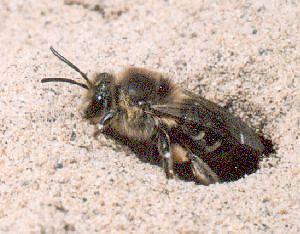The First Bee of Spring
It is not natural for native plants here to flower in mid March, as my crocuses do. Even in early April, only in open woods are there insects about to pollinate flowers. But, hungry for something of nature in the new environment around me that we call a city, I've planted them throughout the mowed area around my home. They came originally from mountains in Turkey, where insects could warm up their flight muscles at lower, warmer altitudes, then fly up the hills in search of food.
For two weeks each spring, they waited in vain for their chance at life as they see it - pollination and seed production. I had mixed feelings sometimes, watching them open and close with the sun. Was it right for me to enjoy their life of sterility? Then, the first bee of spring would arrive, at the peak of warmth just after noon. Wings buzzing non stop to keep warm, she would quickly grab the most easily accessible pollen for a few minutes, then head back to the warmth of her nest before she could be chilled into immobility.
I used to follow her, up the full length of Cadboro, to the rocky patch between Ogilvie and the Queensway - a kilometer of barren brown, for there are few here who dare to defile their lawns with 'weeds' such as flowers. There, I would find her kin, busily foraging along the edges of a brushy area that still survived the development plans for a "vibrant new Gloucester City Center". It was still enough for the first bees of spring to replenish their larder.
No more. It's all gone - covered with asphalt for big box store parking.
Why must we always equate development with sterility? Should we all not rejoice in the first bee of spring? Should we not, even more, wish that our children's children will too?
Imitation Astroturf lawns don't feed hungry people, provide shelter, or provide warmth. Surely some of that space can be used for a better purpose than for 12-foot swamp grass, for that's what bluegrass is, shackled and starved into submission by overzealous mowing?
If you would join me in making space for nature around your home, set aside a patch of 'lawn' this year for a meadow or flowering ground covers. And, support natural spaces for your community that support the insects that share this world with us.

Colletes compactus digs its burrow in sand, then lines it with a plastic-like film to reduce moisture loss during the heat of summer.

Apis mellifera, our social bee, stocking up with fresh pollen